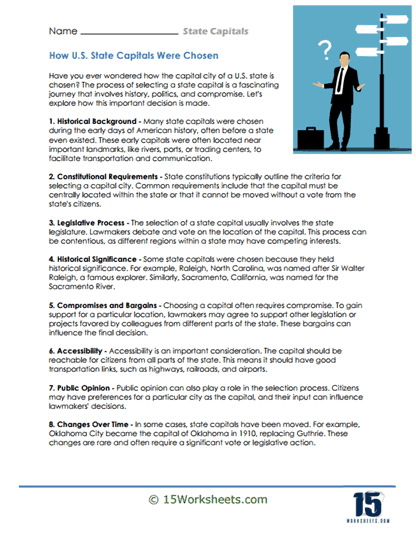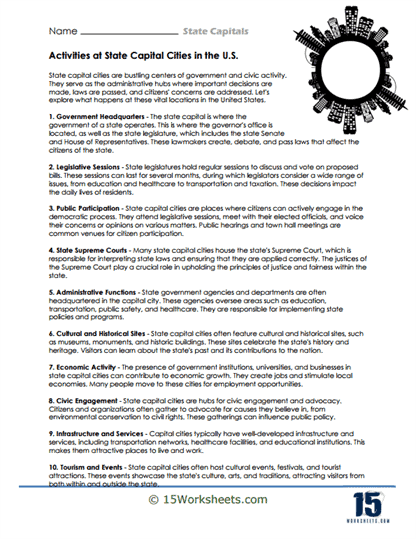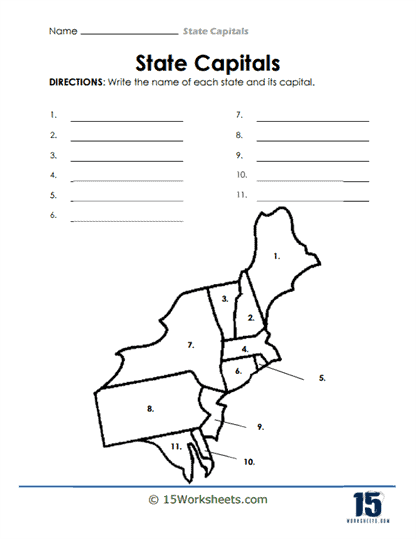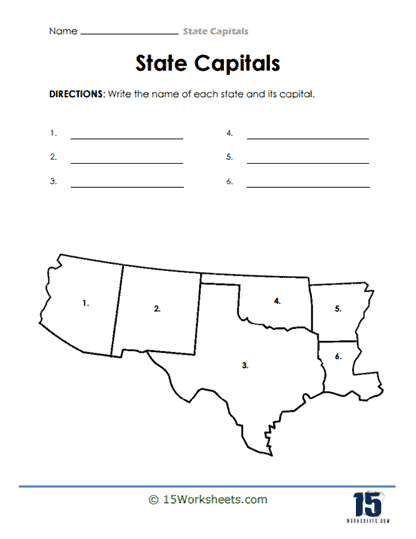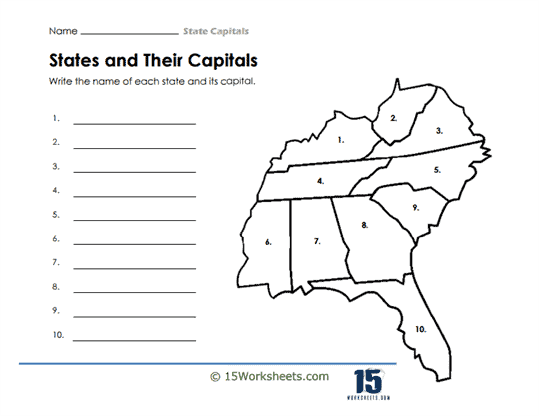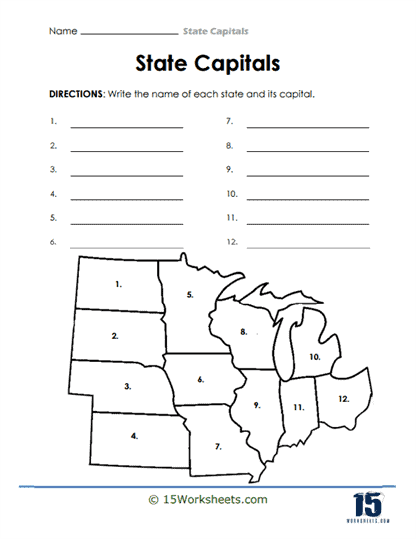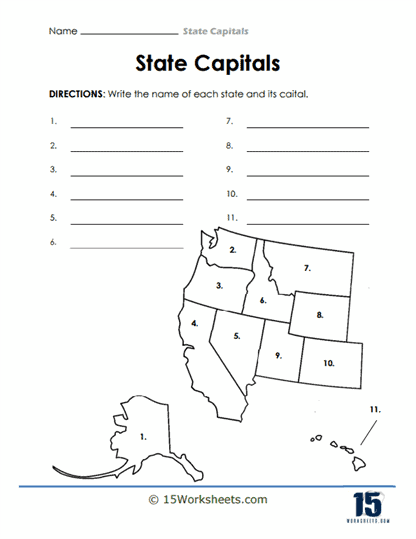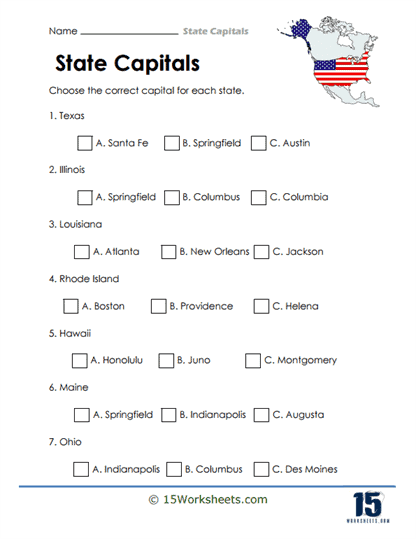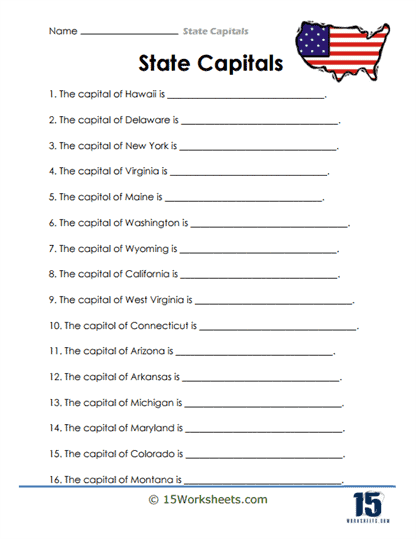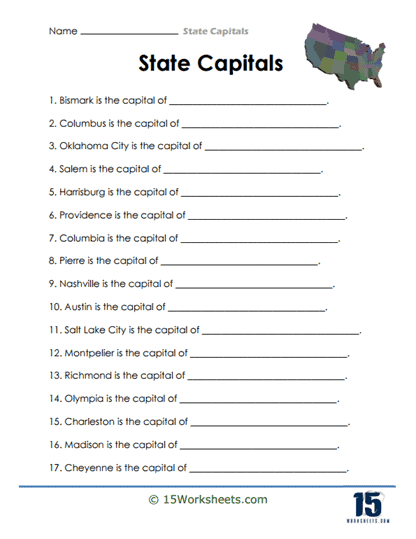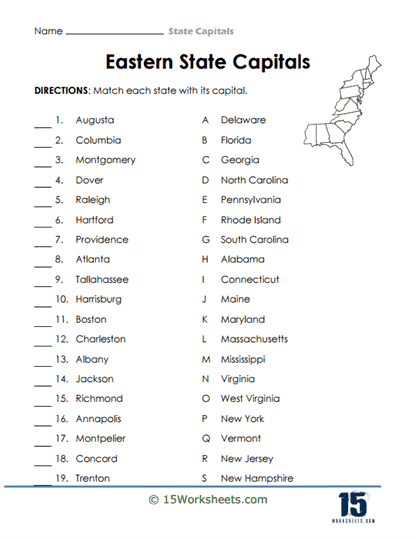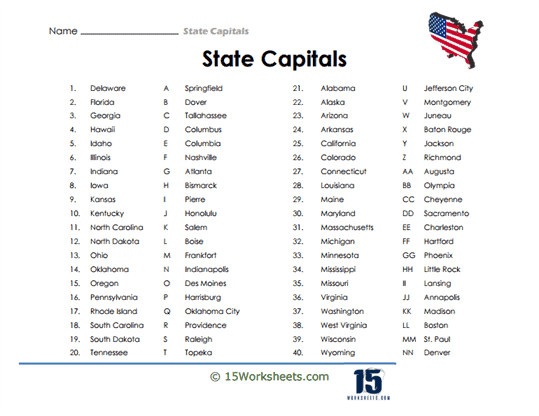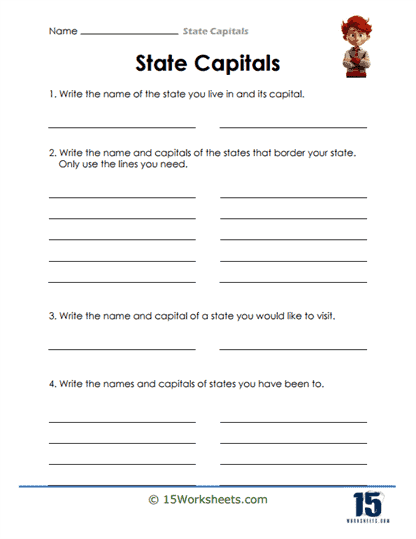State Capitals Worksheets
About These 15 Worksheets
State Capitals Worksheets are educational tools designed to help students learn and memorize the capitals of states in a country, most commonly the United States. These worksheets are versatile resources used by educators, parents, and self-learners to enhance geographical knowledge and cognitive recall abilities. The design of State Capitals Worksheets varies widely, but they commonly include a range of exercises aimed at reinforcing the association between each state and its capital. Below are the different types of exercises you would typically find on these types of worksheets, each serving a unique role in the learning process.
Matching Exercises – Matching exercises are fundamental components of State Capitals Worksheets. They require students to draw lines or write the names of capitals next to the corresponding states. This exercise type promotes active recall and the reinforcement of state-capital pairs. It’s an effective method for initial learning and periodic review.
Multiple Choice Questions – These questions provide a list of options for the capital of a given state. Students must select the correct answer from the choices. This format helps students learn to distinguish between different capitals and often includes plausible distractors to deepen the learning process by requiring students to recall and confirm their knowledge actively.
Fill-in-the-Blank Exercises – In these exercises, students fill in the missing capitals or states in provided sentences. This format tests the student’s recall ability and ensures that they can remember the capital without the aid of cues. It’s a step up in difficulty from multiple-choice questions because it requires free recall rather than recognition.
Puzzles – Word scrambles present the names of capitals or states in a jumbled format. Students need to unscramble the letters to form the correct words. This exercise type is excellent for cognitive engagement, as it requires problem-solving in addition to recall. Word search puzzles contain a grid of letters with state capitals hidden among them. Students must find and circle the names of capitals. This activity is less about recall and more about recognition, but it still serves as a useful tool for reinforcing the names of capitals in a fun and engaging way. Crossword puzzles integrate state capitals into a fun and engaging format. Clues are given for each word, referring to either the state or its capital, and the student fills in the appropriate answer. This exercise type is particularly good for reinforcing memorization and making the learning process enjoyable.
Variety of Question Types – These quizzes prompt students with either the state or the capital and require a written response. Unlike fill-in-the-blank exercises, short answer quizzes do not provide a sentence structure, making them more challenging and effective for testing knowledge. These questions present a statement about a state and its capital, and students must determine the accuracy of the statement. This exercise type is excellent for correcting misconceptions and reinforcing accurate information. More advanced worksheets might include essay questions, asking students to write about a particular state and its capital, perhaps including historical, geographical, or cultural information. This type of exercise integrates writing skills with the memorization of state capitals, making the learning process more comprehensive.
Creative Writing Prompts – Some worksheets incorporate creative writing prompts that ask students to write a story or a descriptive paragraph about a particular state and its capital. This approach not only reinforces the state-capital relationship but also encourages students to engage with the material creatively and personally.
From matching exercises to creative writing prompts, each type of exercise targets different cognitive skills and aspects of learning, ensuring that students not only memorize state capitals but also understand and engage with them in a meaningful way. Through repetitive practice and diverse methods of engagement, these worksheets are instrumental in helping students solidify their knowledge of geography and develop a keen understanding of the political landscape of their country.
Why Are State Capitals Significant?
State capitals hold significant importance in the United States for a multitude of reasons, spanning historical, political, economic, and cultural dimensions. Understanding the role and significance of state capitals involves delving into the fabric of the nation’s governance structure, cultural identity, and historical development.
Centers of Government and Administration – State capitals are the administrative hubs of their respective states. They house the primary governmental buildings, including the state legislature, the governor’s office, and various state departments. This concentration of political power makes state capitals crucial for the governance and legislative processes within the state. Laws are debated, passed, and enforced here, shaping the lives of the state’s residents.
State capitals, being at the heart of state policy-making, often become platforms for innovation in governance and public policy. They are sites where new ideas are tested and implemented, from environmental policies to educational reforms, setting precedents that other states or even the federal government might follow.
Historical Significance – Many state capitals were chosen or established due to their historical importance. Some were the sites of significant historical events, such as major battles, important meetings, or the signing of critical treaties. This historical relevance adds to the cultural richness of the capital, making it not just an administrative center but also a repository of the state’s history.
Economic and Cultural Hubs – State capitals often become economic centers due to the concentration of government services and the infrastructure that supports these services. This includes legal firms, lobbying groups, consulting firms, and contractors that work closely with government entities. Moreover, state capitals attract businesses due to the stable economic environment and the proximity to legislative processes, leading to job creation and economic growth within the region.
State capitals frequently host a range of cultural institutions, such as museums, libraries, theaters, and arts centers, reflecting and nurturing the cultural identity of the state. Additionally, capitals often house significant educational institutions, including universities and research centers, contributing to the educational advancement of the state and providing a skilled workforce.
Tourism and Symbols of State Identity – The architecture and historical sites in state capitals draw tourists, contributing to the state’s economy and its cultural exchange. State capitals often feature iconic buildings like state capitol buildings, which are architecturally significant and symbolize state identity and pride. These buildings and the events hosted in state capitals serve as focal points for state celebrations, holidays, and civic engagement.
The location of a state capital is often a strategic decision, historically intended to distribute power and resources more evenly across the state. This decision could be aimed at preventing one city (often the largest or most economically powerful) from having disproportionate influence, ensuring a more balanced development and representation of various regions within the state.
How Were Capital Cities Chosen?
The selection of state capitals in the United States was a complex process influenced by a multitude of factors. From strategic geographical placement to political compromise, economic considerations, and even public input, the choice of each capital represents a unique chapter in the state’s history. These decisions were not only about selecting a location for government buildings but also about reflecting the identity, aspirations, and practical needs of the state and its residents.
Historical and Geographical Considerations
Early in the nation’s history, state capitals were often located in central or strategically important locations. The goal was to ensure accessibility for residents and to facilitate travel and communication within the state. Capitals were commonly situated along major waterways or at central points to be reachable from all parts of the state. For instance, Albany, the capital of New York, was chosen for its strategic location on the Hudson River, facilitating trade and travel.
While some capitals were chosen for their central location, others were selected because they were economic or population centers at the time. However, as states evolved, the economic and demographic centers often shifted, leaving some capitals relatively small or isolated compared to the state’s primary urban centers.
In the early years of the nation, concerns about safety and defense against foreign powers or local conflicts could influence the choice of a capital. Capitals were sometimes located inland or in less conspicuous locations to offer protection from potential attacks or invasions.
Political Compromise and Balance of Power
Political negotiations and compromises played a significant role in the selection of state capitals. In many cases, the choice was a result of a compromise to balance regional interests and power structures within a state. For example, the decision to place a capital might have been a way to appease a powerful regional faction or to prevent any single city from dominating state politics, especially if there was a large, influential city elsewhere in the state.
Some state capitals were chosen because of their symbolic or historical significance, representing the state’s heritage, identity, or important events in the state’s history. This choice reflects a desire to honor the past and create a capital that embodies the state’s values and character.
The selection or relocation of a state capital often involved legislative action, with debates and votes within state legislatures. Over time, some states chose to move their capitals for various reasons, including accessibility, population shifts, economic development, or after reassessment of their geographical or strategic positioning.
In some instances, the choice of a state capital was put to a public vote, allowing residents to participate in the decision. This democratic approach was a way to ensure that the capital location reflected the will and needs of the state’s populace.
The availability of land for government buildings and related infrastructure was a practical consideration. Some capitals were planned cities, designed from the ground up to serve as the administrative center of the state. This allowed for systematic urban planning, ensuring that the capital would have the necessary facilities and layout to serve its functions effectively.
List of United States Capital Cities
Alabama – Montgomery
Alaska – Juneau
Arizona – Phoenix
Arkansas – Little Rock
California – Sacramento
Colorado – Denver
Connecticut – Hartford
Delaware – Dover
Florida – Tallahassee
Georgia – Atlanta
Hawaii – Honolulu
Idaho – Boise
Illinois – Springfield
Indiana – Indianapolis
Iowa – Des Moines
Kansas – Topeka
Kentucky – Frankfort
Louisiana – Baton Rouge
Maine – Augusta
Maryland – Annapolis
Massachusetts – Boston
Michigan – Lansing
Minnesota – St. Paul
Mississippi – Jackson
Missouri – Jefferson City
Montana – Helena
Nebraska – Lincoln
Nevada – Carson City
New Hampshire – Concord
New Jersey – Trenton
New Mexico – Santa Fe
New York – Albany
North Carolina – Raleigh
North Dakota – Bismarck
Ohio – Columbus
Oklahoma – Oklahoma City
Oregon – Salem
Pennsylvania – Harrisburg
Rhode Island – Providence
South Carolina – Columbia
South Dakota – Pierre
Tennessee – Nashville
Texas – Austin
Utah – Salt Lake City
Vermont – Montpelier
Virginia – Richmond
Washington – Olympia
West Virginia – Charleston
Wisconsin – Madison
Wyoming – Cheyenne

